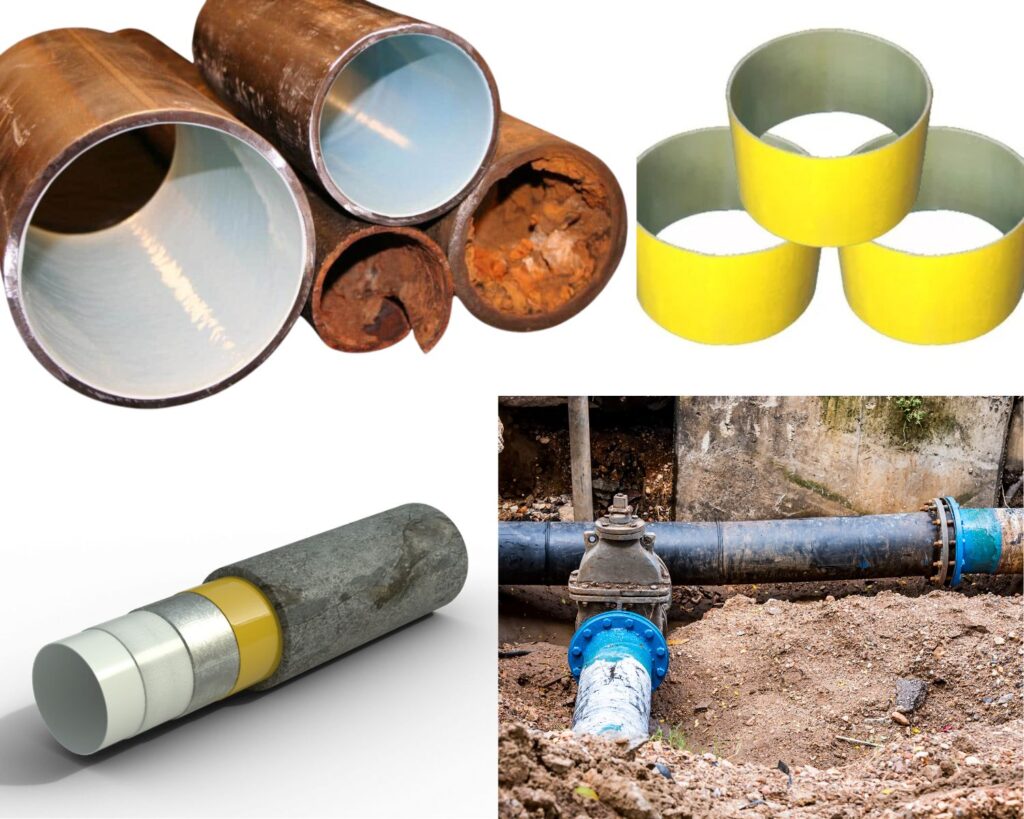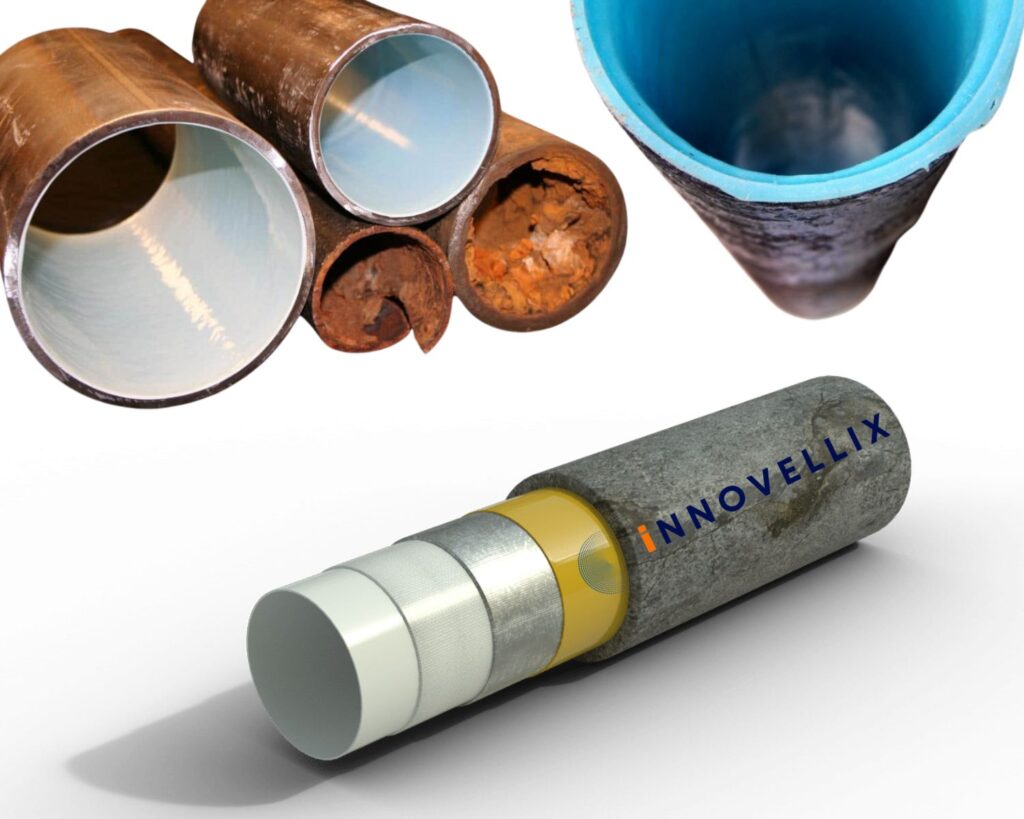
Pipe relining is an innovative trenchless pipe repair method that renews old, worn out pipes without the need for expensive and disruptive excavation. This article from the experts at Innovellix will teach you all about pipe relining, including how it works, its benefits over traditional pipe replacement, typical applications, and what to expect during the pipe relining process.
What is Pipe Relining?
Pipe relining, also referred to as CIPP (Cured-In-Place Pipe) lining, involves installing a resin-saturated liner inside an existing pipe and curing it in place to form a smooth, seamless “pipe within a pipe” without digging or destruction. The resin cures and hardens, sealing cracks and holes in the original pipe. Once cured, the epoxy sewer pipe lining restores structural integrity, flow capacity, and service life of the pipe without the need to replace it. Pipe relining can extend the life of aging sewer, drain, and water pipes by 50 years or more.
How Does Trenchless Pipe Relining Work?
Pipe relining utilizes trenchless technology – advanced techniques for installing, rehabilitating, and replacing underground infrastructure with minimal surface disruption. The basic pipe relining process involves:
- Inspecting the pipe interior using a CCTV (closed-circuit television) camera. The inspection locates pipe defects and identifies the best access points.
- Cleaning and preparing the old pipe by removing debris, roots, deposits, and protrusions using high-pressure water jets.
- Installing a resin-saturated felt liner through an existing manhole or cleanout.
- Curing the liner using hot water, steam, or UV light to harden the resin and bond it to the old pipe walls. Curing times range from 30 minutes to a few hours depending on the curing method.
- Trimming the ends of the cured liner at entry and exit points using a robotic cutter.
Once cured, the pipe relining forms a jointless, watertight “pipe within a pipe” restoring structural stability and flow capacity. The process causes minimal disruption to property or landscaping with no need for expensive excavation or pipe replacement.

Pipe Relining vs Traditional Pipe Replacement

Pipe Relining
Pipe relining is a trenchless method to repair damaged pipes without the need for excavation. This innovative process involves inserting a resin-saturated liner into the existing pipe and curing it to form a new, jointless pipe within the old one. Relining restores structural integrity, flow capacity, and extends the life of aging pipes at a fraction of replacement cost. Pipeline owners can save millions by choosing pipe relining over traditional pipe replacement methods that require digging, landscape destruction, and major home disruption. Relining causes minimal disturbance while providing long-lasting repairs.
Traditionally, fixing broken pipes required excavating the pipe, removing it entirely, and replacing it with a new pipe, which is highly disruptive and expensive. Pipe relining offers major advantages over traditional “dig and replace” pipe replacement:
| Benefit | Pipe Relining | Pipe Replacement |
|---|---|---|
| Cost | The cost of relining solutions depends on many factors. Please contact us for a quote. | $400+ per linear foot |
| Excavation | Trenchless – no digging required | Requires extensive excavation |
| Time | 1-2 days | 2+ weeks |
| Yard disruption | Minimal | Major disruption |
| Traffic disruption | None | Road/lane closure needed |
| Structural strength | Equal or better than original pipe | Depends on new pipe type |
As shown in the table, pipe relining saves over 50% compared to replacement. It also minimizes disruption, restores structural integrity, and extends service life equal to or greater than a new pipe.
Typical Applications of Pipe Relining
Pipe relining offers an efficient and cost-effective solution for rehabilitating aging drainage systems. It suits many pipe types and sizes. Typical pipe relining applications include:
- Sewer pipes: Relining fixes root intrusion, cracks, leaks, holes, and corrosion in old sewer pipes. It prevents infiltration while restoring flow capacity.
- Drain pipes: Relining renews old drain pipes, rain gutter downspouts, and French drains suffering from cracks, holes, root damage, or poor joints.
- Water pipes: Relining stops leaks and restores adequate water volume/pressure in deteriorated supply pipes.
- Underground pipes: Relining renews underground pipes under buildings, driveways, landscaping etc. without destruction or excavation.
Pipe relining is suitable for pipes 4 inches or larger made of:
- Concrete
- Clay
- Cast iron
- Galvanized steel
- PVC/CPVC
- ABS
It also suits pipes in various shapes like round, oval, or egg-shaped pipes.
What to Expect During Pipe Relining
Inspection Phase The first step is inspecting the pipe using a robotic CCTV camera. The camera inspection locates pipe defects and identifies the best access points for pipe relining equipment. If the pipe suffers from major damage like collapses or requires realignment, pipe relining may not be feasible, and full replacement recommended instead. Cleaning Phase Next is cleaning the pipe interior. Cleaning crews use high-pressure water jets to scour the pipe walls and remove old pipe coatings, rust, mineral deposits, roots, protruding service connections, and debris to prepare for pipe relining. The high-pressure water jets leave the pipe interior smooth and clean. Bypass Pumping Phase For sewer pipe relining, crews set up temporary bypass pumping to reroute flows around the section undergoing repair. This protects residences and prevents sewage backups during the project. The pumped sewage flows to a downstream manhole for treatment. Installation Phase A resin-saturated felt tube matching the pipe size gets inverted through an existing manhole or cleanout using air or water pressure. The liner tube coats the interior pipe surface as it inverts. Installation of the impregnated liner takes 30 minutes to a few hours depending on the pipe length and difficulty of access. Curing Phase Curing the liner using hot water, steam, or UV light polymerizes the resin into a hard, smooth pipe lining. Curing times range from 20 minutes for small pipes cured with UV light to 12 hours for large pipes cured with hot water. Monitoring sensors track the curing process. Cool Down & Finishing Phase After curing, crews must cool the hardened liner before trimming it at entry and exit points. A robotic cutter trims the liner, restoring lateral connections and flow. The finishing crew then removes all equipment and restores the site.
Finding Professional Pipe Relining Contractors
Choosing reputable contractors with extensive pipe relining experience is vital for a successful project. Key credentials to seek in a professional pipe relining company include:
- Industry experience: Look for established companies with 10+ years performing pipe relining. They understand advanced CIPP processes.
- Proper licensing & insurance: Ensure the contractor carries appropriate licenses, bonding, and liability insurance to perform pipe relining in your state.
- Manufacturer certifications: Opt for ICPA-certified contractors trained and approved by major CIPP resin manufacturers like Aegion. ICPA-trained specialists understand proper installation procedures.
- Quality equipment: Choose a contractor with state-of-the-art CCTV, jetting, inversion, and curing equipment to deliver quality pipe relining.
- Warranties: Only work with companies that provide multi-year warranties on pipe relining materials and workmanship.
As leading local specialists in pipe relining and infrastructure rehabilitation, Innovellix meets all the above credentials for superior trenchless pipe repair services.

Pipe Relining Cost
Pipe relining costs $50-150 per linear foot on average, saving over 50% versus traditional pipe replacement. Exact pricing depends on:
- Pipe size & length: Costs scale with pipe diameter and length.
- Pipe material & condition: Cleaning/prepping costs more for very deteriorated pipes.
- Site accessibility: Difficult access adds complexity and expense.
- Curing method: UV curing costs more than hot water or steam curing.
- Excavation needs: Some projects require minor excavation, increasing costs.
Accurate pricing requires a detailed inspection by a professional contractor like Innovellix to develop a project-specific quote.
Pipe Relining FAQs
How long does pipe relining take? Most projects take 1-3 days from start to finish. Installation and curing of the pipe lining takes just a few hours, but prepping the old pipe and bypass pumping adds time. Is pipe relining permanent? Yes, pipe relining is a proven long-term solution, restoring life expectancy equal to or greater than a new pipe. Epoxy liners last 50+ years. Can you reline any pipe? Pipe relining suits pipes 4 inches or larger made of concrete, clay, steel, cast iron, galvanized metal, ABS, PVC etc. Severely damaged pipes may still need replacement. Do I need to move out during pipe relining? No. Pipe relining is a trenchless pipe repair method that does not require digging or destruction. Residents can usually stay in their homes except for a few hours when crews make connections.
Why Choose Innovellix for Your Pipe Relining Project
With over 25 years of experience, Innovellix leads the way in trenchless infrastructure repair and rehabilitation. We handle pipe relining projects of any scale from small residential to large municipal jobs. Benefits of choosing Innovellix include:
- Industry-leading expertise: Our trenchless repair specialists carry ICPA training and have decades of hands-on CIPP relining experience.
- Turnkey service: We handle all aspects of your pipe relining project including inspection, cleaning, bypass pumping, installation, and finishing.
- Manufacturer certifications: We utilize top-tier CIPP products and work closely with major resin manufacturers.
- Efficiency & cost savings: Our trenchless methods fix your pipes with minimal destruction, saving time and money.
- Multi-year warranties: We stand behind our pipe relining workmanship with industry-leading technics.
For professional pipe relining services in the Western Australia, call Innovellix or email us to request a free quote! Our friendly staff is ready to answer your pipe relining questions and develop custom solutions to renew your aging infrostracture.
